How To Create Entities For A Service In Splunk
Splunk - Schedules and Alerts
Scheduling is the process of setting upwards a trigger to run the study automatically without the user's intervention. Below are the uses of scheduling a written report −
-
By running the aforementioned report at different intervals: monthly, weekly or daily, we can get results for that specific menses.
-
Improved operation of the dashboard as the reports finish running in the background before the dashboard is opened by the users.
-
Sending of reports automatically via e-mail later it finishes running.
Creating a Schedule
A schedule is created past editing the study'south schedule characteristic. Nosotros go to the Edit Schedule pick on the Edit button every bit shown in the image beneath.
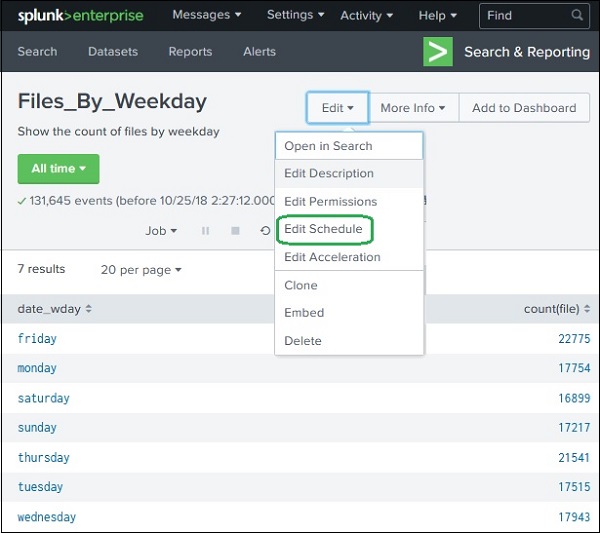
On clicking the edit schedule button, we get the next screen which lays out all the options for creating the schedule.
In the below example, nosotros accept all the default options and the report is scheduled to run every week on Monday at six AM.
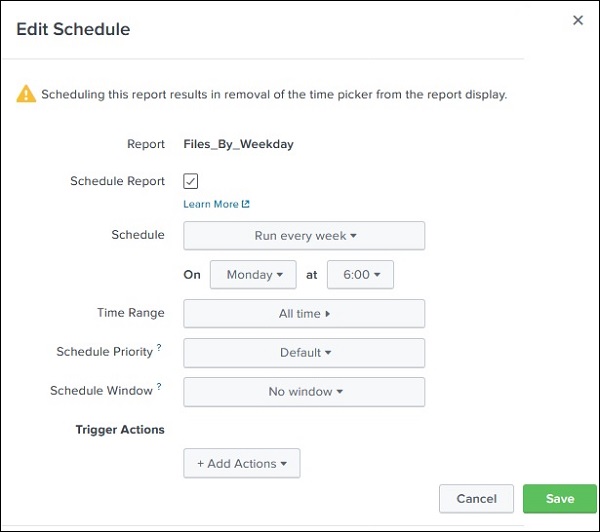
Important Features of Scheduling
The following are the important features of scheduling −
-
Time Range − It indicates the time range from which the report must fetch the data. Information technology can exist terminal 15 minutes, last iv hours or final week etc.
-
Schedule Priority − If more than i study is scheduled at the same time so this will determine the priority of a specific report.
-
Schedule Window − When there are multiple report schedules with aforementioned priority so nosotros can cull a time window which volition help the report to run at anytime during this window. If information technology is 5 minutes, so the report volition run within 5 minutes of its scheduled time. This helps in enhancing the performance of the scheduled reports by spreading their run time.
Schedule Actions
The schedule deportment are meant to take some steps after the study is run. For example, yous may desire to ship an e-mail stating the run condition of the report or run some other script. Such actions can exist carried out past setting the option by clicking on Add Actions button as shown below −
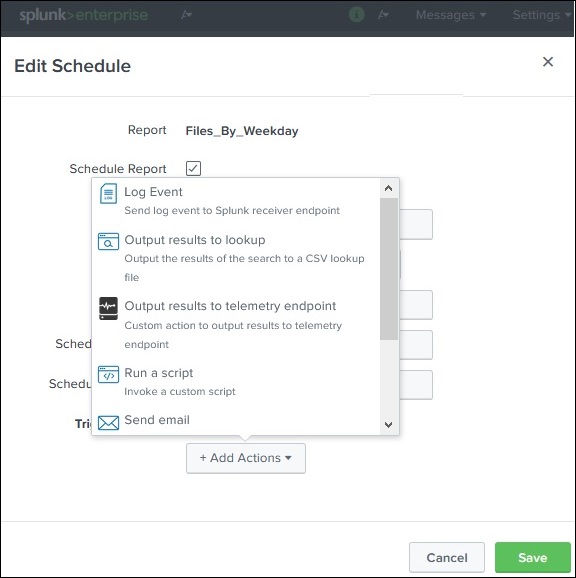
Alerts
Splunk alerts are actions which go triggered when a specific benchmark is met which is divers by the user. The goal of alerts can be logging an action, sending an email or output a effect to a lookup file, etc.
Creating an Alert
Yous create an alarm by running a search query and saving its outcome as an alert. In the below screenshot, we take the search for daywise file count and salve the result as an alert by choosing the Save As option.
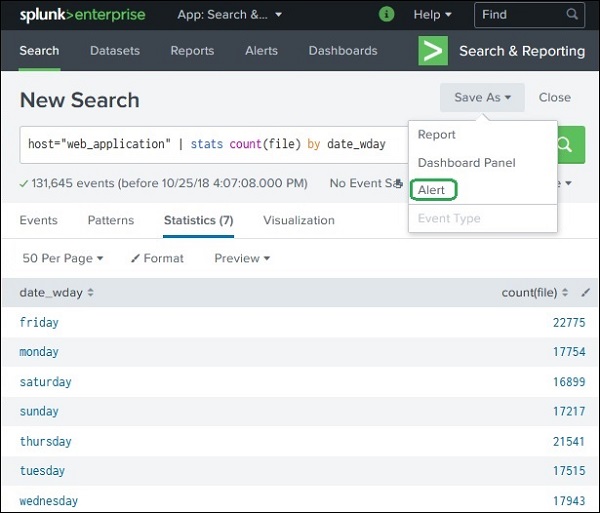
In the adjacent screenshot, we configure the alert properties. The below image shows the configuration screen −
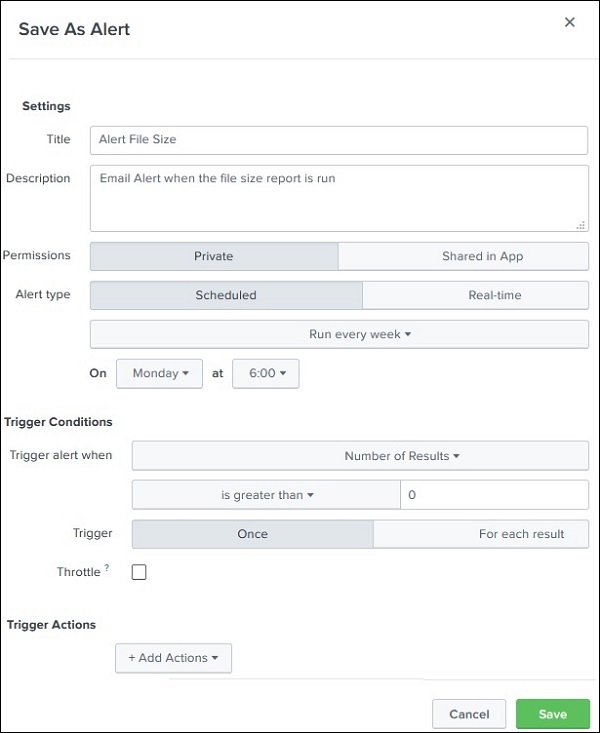
The purpose and choices of each of these options is explained below −
-
Title − It is the proper noun of the alert.
-
Clarification − It is the detailed description of what the warning does.
-
Permission − Its value decided who can access, run or edit the alert. If declared private, then but the creator of the alert has all the permissions. To exist accessed by others the option should be changed to Shared in App. In this case everyone has read admission but only ability user has the edit access for the warning.
-
Alert Type − A scheduled alarm runs at a pre-divers interval whose run time is divers by the day and time chosen from the drop downs. But the other option on real-time warning causes the search to run continuously in the background. Whenever the condition is met, the alarm action is executed.
-
Trigger status − The trigger condition checks for the criteria mentioned in the trigger and sets off the change only when the alert criteria is met. You can define number of results or number of sources or number of hosts in the search result to trigger the warning. If it is gear up for once, it volition execute merely once when the result condition is met but if it is prepare to For each Event, then it will run for every row in the outcome set up where the trigger condition is met.
-
Trigger Actions − The trigger actions tin can give a desired output or send an email when the trigger condition is met. The below prototype shows some of the of import trigger deportment available in Splunk.
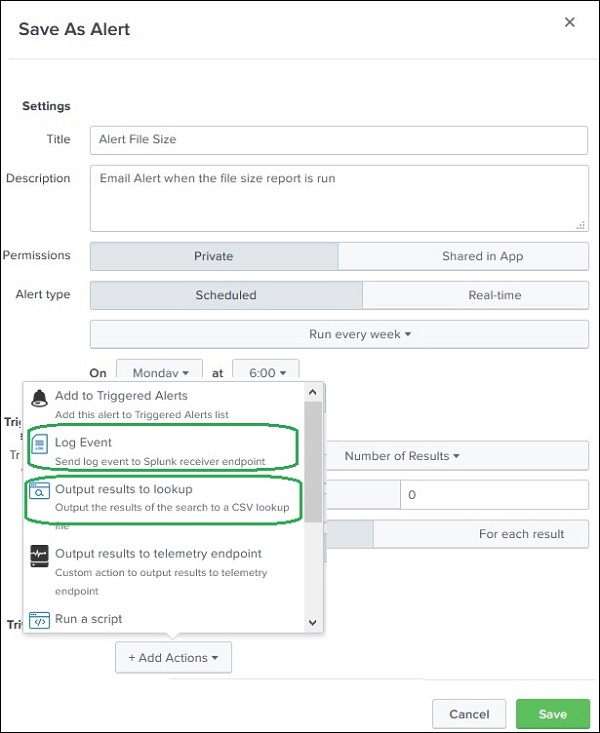
How To Create Entities For A Service In Splunk,
Source: https://www.tutorialspoint.com/splunk/splunk_schedules_and_alerts.htm
Posted by: jonesvaniffew.blogspot.com


0 Response to "How To Create Entities For A Service In Splunk"
Post a Comment